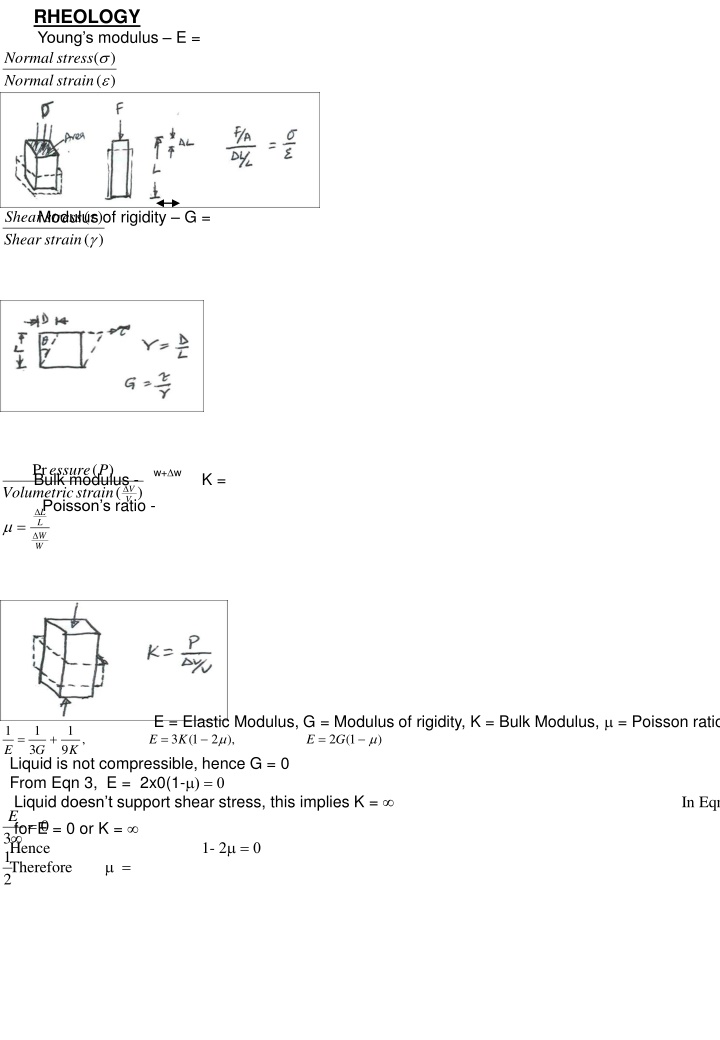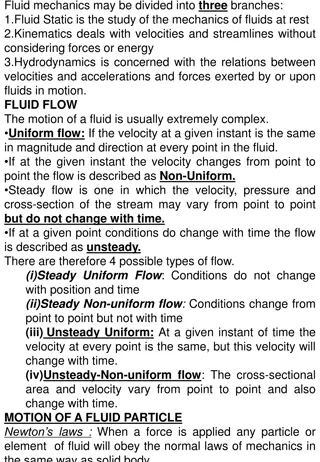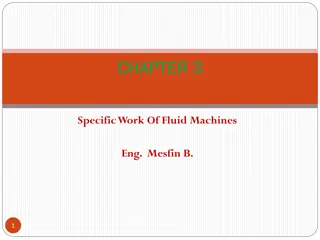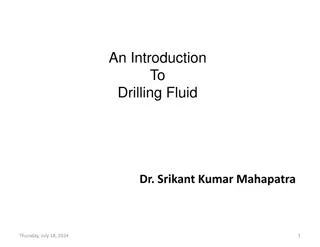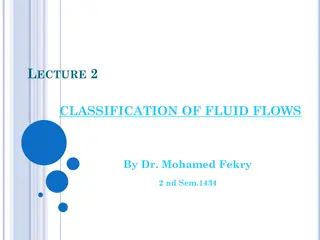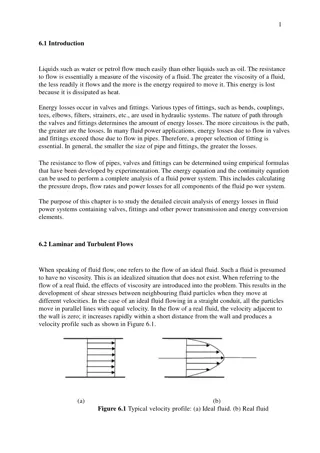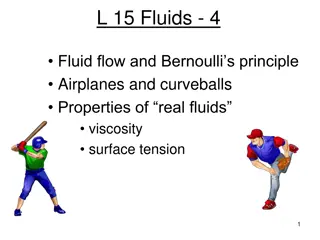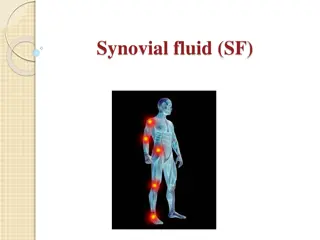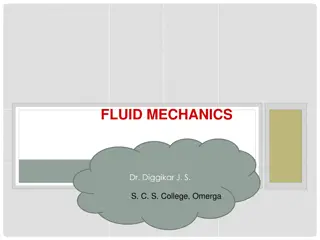Rheology and Viscosity in Fluid Dynamics
Rheology explores Young's Modulus, Modulus of Rigidity, Bulk Modulus, and Poisson's Ratio. Viscosity delves into Newtonian and Non-Newtonian Fluids, dynamic and kinematic viscosity, and units of measurement.
Download Presentation

Please find below an Image/Link to download the presentation.
The content on the website is provided AS IS for your information and personal use only. It may not be sold, licensed, or shared on other websites without obtaining consent from the author.If you encounter any issues during the download, it is possible that the publisher has removed the file from their server.
You are allowed to download the files provided on this website for personal or commercial use, subject to the condition that they are used lawfully. All files are the property of their respective owners.
The content on the website is provided AS IS for your information and personal use only. It may not be sold, licensed, or shared on other websites without obtaining consent from the author.
E N D
Presentation Transcript
RHEOLOGY Young s modulus E = ( ) Normal stress ( ) Normal strain stress Modulus of rigidity G = ( ) Shear ( ) Shear strain Pr Bulk modulus - Poisson s ratio - ( ) essure P w+ w K = ( ) Volumetric = strain V V L L W W E = Elastic Modulus, G = Modulus of rigidity, K = Bulk Modulus, = Poisson ratio 1 E 1 G 1 K = + = = , 3 1 ( 2 ), 2 1 ( ) E K E G 3 9 Liquid is not compressible, hence G = 0 From Eqn 3, E = 2x0(1- ) = Liquid doesn t support shear stress, this implies K = for E = 0 or K = 1- 2 = In Eqn E = 0 Hence Therefore = 3 1 2
VISCOSITY Newtonian and Non-Newtonian Fluids Viscosity is that property of a fluid that gives rise to forces that resist the relative movement of adjacent layers in the fluid. Viscous forces are of the same character as shear forces in solids and they arise from forces that exist between the molecules. If two parallel plane elements in a fluid are moving relative to one another, it is found that a steady force must be applied to maintain a constant relative speed. This force is called the viscous drag because it arises from the action of viscous forces. Consider the system shown in Fig 1.
and it is denoted by the symbol m (mu). From the definition of viscosity we can write F/A = mv/Z (3.14) where F is the force applied, A is the area over which force is applied, Z is the distance between planes, v is the velocity of the planes relative to one another, and m is the viscosity. By rearranging the eqn. (3.14), the dimensions of viscosity can be found. [m] = FZ = [F][L][t] = [F][t] = [M][L]-1[t]-1 Av [L2][L] [L]2 There is some ambivalence about the writing and the naming of the unit of viscosity; there is no doubt about the unit itself which is the N s m-2, which is also the Pascal second, Pa s, and it can be converted to mass units using the basic mass/force equation. The older units, the poise and its sub- unit the centipoise, seem to be obsolete, although the conversion is simple with 10 poises or 1000 centipoises being equal to 1 N s m-2, and to 1 Pa s. The new unit is rather large for many liquids, the viscosity of water at room temperature being around 1 x 10-3 N s m-2 and for comparison, at the same temperature, the approximate viscosities of other liquids are acetone, 0.3 x 10- 3 N s m-2; a tomato pulp, 3 x 10-3; olive oil, 100 x 10-3; and molasses 7000 N s m-2. Viscosity is very dependent on temperature decreasing sharply as the temperature rises. For example, the viscosity of golden syrup is about 100 N s m-2 at 16 C, 40 at 22 C and 20 at 25 C. Care should be taken not to confuse viscosity m as defined in eqn. (3.14) which strictly is called the dynamic or absolute viscosity, with m/r which is called the kinematic viscosity and given another symbol. In technical literature, viscosities are often given in terms of units that are derived from the equipment used to measure the viscosities experimentally. The fluid is passed through some form of capillary tube or constriction and the time for a given quantity to pass through is taken and can be related to the viscosity of
obeyed by fluids such as water. However, for many of the actual fluids encountered in the food industry, measurements show deviations from this simple relationship, and lead towards a more general equation: t = k(dv/dz)n (3.15) which can be called the power-law equation, and where k is a constant of proportionality. Where n = 1 the fluids are called Newtonian because they conform to Newton's equation (3.14) and k = m; and all other fluids may therefore be called non-Newtonian. Non- Newtonian fluids are varied and are studied under the heading of rheology, which is a substantial subject in itself and the subject of many books. Broadly, the non- Newtonian fluids can be divided into: (1) Those in which n < 1. As shown in Fig. 3.6 these produce a concave downward curve and for them the viscosity is apparently high under low shear forces decreasing as the shear force increases. Such fluids are called pseudoplastic, an example being tomato puree. In more extreme cases where the shear forces are low there may be no flow at all until a yield stress is reached after which flow occurs, and these fluids are called thixotropic. (2) Those in which n > 1. With a low apparent viscosity under low shear stresses, they become more viscous as the shear rate rises. This is called dilatancy and examples are gritty slurries such as crystallized sugar solutions. Again there is a more extreme condition with a zero apparent viscosity under low shear and such materials are called rheopectic. Bingham fluids have to exceed a particular shear stress level (a yield stress) before they start to move.
